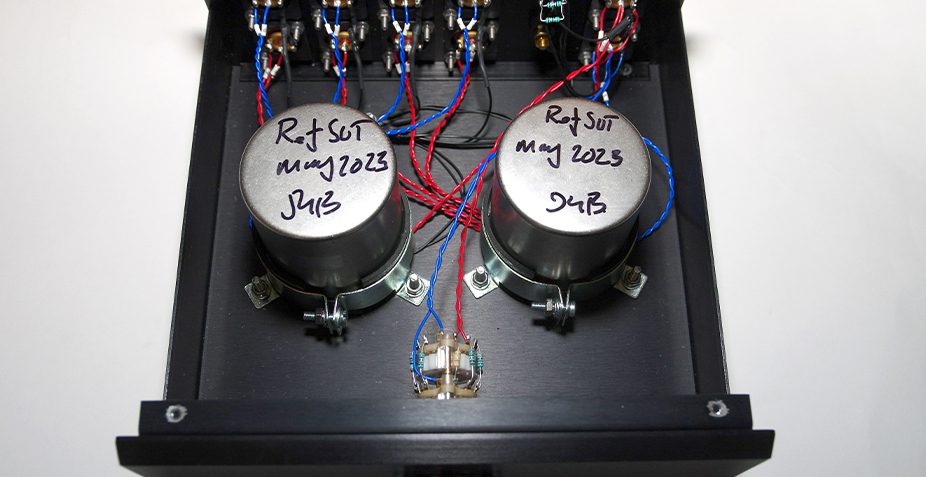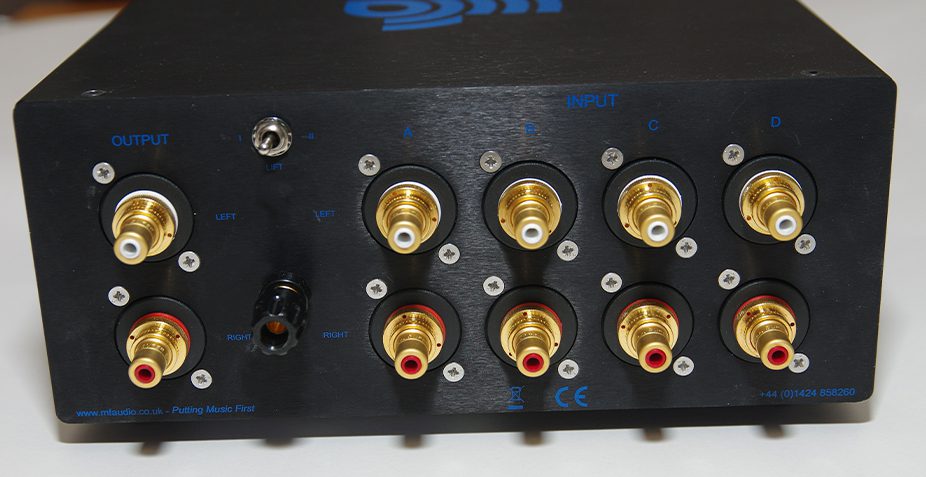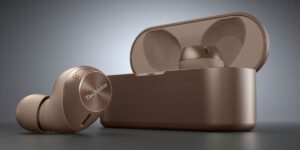
The output voltage from a moving coil cartridge is so low – typically 10 times lower than the average moving magnet – that a separate step-up device is needed. That could be an active head amplifier or, like the Music First Audio device I am reviewing here, a passive transformer.
There has always been a heated debate about whether a transformer is a better solution than a head amplifier. Many believe the transformer is a better way because it does it passively and without adding the noise that an active amplification stage will add. It is also argued that a transformer is preferable because you’re loading the cartridge with something that is similar to its own nature, rather than just loading it with a resistor and then adding as much gain as you can.
Primary Schooling
In a transformer, a primary coil is wound onto a ferromagnetic core causing a magnetic field to flow in the core. A secondary coil provides the output and the secondary voltage is in proportion to the ratio of the number of turns multiplied by the primary voltage. It’s as simple as that, except… it isn’t. Many regard transformer design as a bit of a black art. The choice of materials for, and configuration of, the core, the thickness of its laminations [laminated is regarded as superior to solid-core as they control eddy currents better], the insulation between the laminations and the choice of wire are all critical to the final sound quality.
If you look at professional studio microphones, they always use transformers. But expertise in transformers is difficult to find, which is where Music First Audio comes in, as it was ideally placed to pick up the baton and run with it.
Hastings-based Music First Audio traces its roots back to the specialist transformer winding company Stevens & Billington set up by MFA founder Jonathan Billington’s father and a Mr C St John Stevens in 1963. They were on the brink of being made redundant from a London-based electronics company and left to set up a business producing inductors and ferrite-cored transformers and mains transformers for many UK-based companies. Mr Stevens left the business in 1971 to pursue his interest in making and restoring musical instruments.
It’s a Family Affair
Jonathan’s father then went into business with Jonathan’s mother to continue making transformers, adding miniature models to the range for use in microphones.
After he completed a degree in electronics and communications engineering, which included acoustics, his mother handed the business over to him in 1990. In 2002, he designed the first of his transformer-based passive pre‑amp and decided to form Music Audio First as part of his plan to turn his hi-fi hobby into a business.

Now Music First Audio, true to its transformer heritage, is producing a range of four transformer-based passive preamps, and four moving coil step-up transformers. It was when I got talking to Billington at a show last year that I decided to take a look his new top-of-the-range Reference SUT.
The MC step-up transformers start with the MC632 at £720, the Baby Classic at £2,034, the Classic V2 at £3,240 and then there is the Reference SUT I am reviewing here at £4,560.
As standard, it offers four inputs with step-up ratios ranging from 1:10 to 1:100. Unusually, where many transformers do this by taking separate taps off the same winding, MFA’s Reference SUT has four completely separate primary windings for each input. This of course explains the stark warning in the manual that connecting more than one cartridge at the same time may cause damage as the one that is playing will generate a signal at the other inputs and that will be fed to the cartridge not in use.
Billington started work on the Reference SUT in 2021 and his goal was to provide flexibility for the user with four step-up ratios. He supplied mine with ratios to suit my cartridge, but the usual four provided are 1:10, 1:20, 1:40 and 1:100.
No taps on us!
Billington tells me that using four separate primary windings, one for each input, reduces resonances and the number of connections in the signal path as there are no taps, and no switch.
The transformer itself uses a large EI core construction and the laminations are made from mu-metal that is 80% nickel and 20% iron. The heat treatment used for the laminations, he tells me, is very important, as is the size of the laminations, and even the amount of paper interleaving between layers of copper as possible.
The coil windings are copper and he has selected what he believes is the ideal gauge to keep the DC resistance down, while also allowing him to leave an air gap between turns of the four primary windings.

Using and connecting the MFA Reference SUT is simplicity itself. The single knob on the front panel selects the load and places an impedance in parallel with the amplifier MM stage’s input impedance. 10k, 20k, 30k, 40k and 80k are provided along with an OC (open circuit) option that does not use a parallel resistor. Billington suggested that for my cartridge, an Audio Note Io1, I would probably find OC was best and that 80k or 40k would ‘soften’ the sound. He was absolutely right, so I stuck with OC. Other than that, just choose the input that gives you the right step-up ration for your cartridge output, which for me was Input 4 at 1:40.
An earth terminal is provided and most times this must be used to prevent hum. It is always good practice to position a transformer as far away from big power supplies as you can to avoid any chance of hum, but the MFA was not too fussed and was pleasingly quiet and hum-free in operation sat between my Audio Note Meishu Tonmeister integrated amp and the TT3 turntable.
My listening was with the components already mentioned and the speakers were either the Russell K. RED 120Se or Audio Note AN-J LX Hemp.
Power and emotion
I started off with ‘Dark Night of the Soul’ from Van Morrison’s Three Chords and the Truth. Straight away I was pleased with the detail, control, power and emotion in his vocals captured by the MFA transformer. The bass line too was full and tuneful and Morrison’s vocal soared as he really used his range and there was no hint or harshness or forwardness. All in all, an excellent performance.
Going back a few years, Ben Sidran’s album Bop City was spun up next. This is a truly superb, dynamic and clean recording and the MFA captured the emotion and character of his vocals and his fleet-fingered piano play. Drums were dry, explosive and powerful and really packed the punch they should, while the bass line was full, fast and tuneful. The track has a very fast pace and the MFA conveyed its urge and impetus well.
A track I love and first heard at my local hi-fi retailer was next, namely ‘Build Me Up from Bones’ by Sarah Jarosz from the album of that name. It is a wonderful track and a great recording with an interesting mix of instruments from Jarosz’s mandolin to cello and pizzicato and bowed violins. The MFA captured the emotion and beauty of her voice, the delicacy of her mandolin play, the body and weight of the cello and the seamless backdrop of violins well.
Finally, I put on ‘Racing in the Streets’ from Bruce Springsteen’s Darkness on the Edge of Town album. This is an achingly beautiful, emotionally charged ballad from Springsteen that is probably my all-time favourite of his. The MFA conveyed the vocal and piano on the intro with excellent detail and integrity. Drum rimshots were clean and when that powerful, deep bass line kicked in it had impact, weight, power and tunefulness. The track was beautifully focused and articulated and signalled to me that we definitely have a class product here.
Taking nothing for granted
Not one to take anything for granted, I also had to hand another transformer I respect greatly at around this price to help me put the MFA into a market context and decide on what kind of value for money it offers. I am pleased to say the MFA passed the test with flying colours and more than held its own against a major competitor.

The Reference SUT from Music First Audio impressed me greatly. It is a well-thought-out product, well made, has the versatility to be a good match for most cartridges out there and offers superb sound quality. I would say it has got to be one of the strongest contenders at this price. I have no hesitation in recommending it. Make sure it is on your list to listen to if you need a step-up transformer at the price/quality level.
Technical specifications
- Type Moving coil step-up transformer
- Inputs Four provided. As tested, these were
Input 1 1:10 step-up ratio for 0.5mV cartridge output
Input 2 1:20 for 0.25mV cartridges
Input 3 1:30 for 0.16mV cartridges
Input 4 1:40 for 0.12mV cartridges - Load switching 10kΩ, 20kΩ, 30kΩ, 40kΩ, 80k and open circuit
- Total harmonic distortion (0.35mV, 1:20 input) 0.022% @ 40Hz; 0.01% @ 1kHz; 0.024% @ 10kHz
- Dimensions (H×W×D) 100mm × 250mm × 216mm
- Finishes Black or silver
- Price £4,560
Manufacturer
Stevens & Billington Ltd
+44(0)1424 858260
By Chris Frankland
More articles from this authorRead Next From Review
See all
PrimaLuna EVO 100 phono preamplifier
- Apr 22, 2024

Reiki Audio SuperSwitch Master Pro + Servant Pro
- Mar 27, 2024

Melco Audio N1-S38 music server
- Mar 27, 2024











